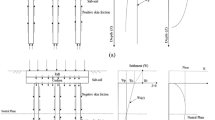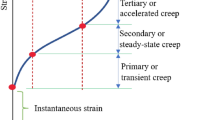Abstract
Extrusion deformation under high geo-stress has always been a key issue in the construction of deep-buried tunnels in soft rock masses. Taking the Yulong Snow Mountain long tunnel of the Lijiang-Shangri-La high-speed railway in Yunnan Province, which undergoes severe deformation under high geo-stress conditions, as an example, this paper expounds the deformation law and mechanical behavior of the initial support structure in the near-fault zone section (450‒600 m away from the Yulong Snow Mountain-Xilu fault) of the tunnel under three kinds of reserved deformation (height-span ratio). First, through an investigation of the surrounding geological characteristics, a stress test of the tunnel site area, and an investigation of the tunnel construction site, the geological structure of the tunnel site area, the geo-stress field environment, and the characteristics of the damage of the supporting structure were ascertained. It was found that the occurrence of a large deformation is the combined result of high geo-stress and poor self-stability of fractured basalt. On-site monitoring was carried out, and the deformation characteristics and mechanical behavior of three kinds of initial support structures were studied from the aspects of initial support deformation, surrounding rock pressure, stress of steel arch, and axial force and bending moment of steel arch. The results show that the reasonable initial support height-span ratio of single-track railway tunnels with high geo-stress and large deformation near the fault zone should be close to 1 and that the reserved deformation should be set between 0.05D and 0.15D according to the actual situation of large deformation.


























Similar content being viewed by others
Data availability
All data that support the findings of this study are available from the corresponding author upon reasonable request.
References
Alejano LR, Rodriguez-Dono A, Veiga M (2012) Plastic radii and longitudinal deformation profiles of tunnels excavated in strain-softening rock masses. Tunn Undergr Space Technol 30:169–182. https://doi.org/10.1016/j.tust.2012.02.017
Barla G, Debernardi D, Sterpi D (2012) Time-dependent modeling of tunnels in squeezing conditions. Int J Geomech 12:697–710. https://doi.org/10.1061/(asce)gm.1943-5622.0000163
Bian K, Liu J, Liu ZP, Liu SG, Ai F, Zheng XQ, Ni SH, Zhang W (2019) Mechanisms of large deformation in soft rock tunnels: a case study of Huangjiazhai Tunnel. Bull Eng Geol Environ 78:431–444. https://doi.org/10.1007/s10064-017-1155-8
Brox D, Hagedorn H (1999) Extreme deformation and damage during the construction of large tunnels. Tunn Undergr Space Technol 14:23–28. https://doi.org/10.1016/s0886-7798(99)00010-3
Cao CY, Shi CH, Lei MF, Yang WC, Liu JW (2018) Squeezing failure of tunnels: a case study. Tunn Undergr Space Technol 77:188–203. https://doi.org/10.1016/j.tust.2018.04.007
Chen ZQ, He C, Xu GW, Ma GY, Wu D (2019a) A case study on the asymmetric deformation characteristics and mechanical behavior of deep-buried tunnel in phyllite. Rock Mech Rock Eng 52:4527–4545. https://doi.org/10.1007/s00603-019-01836-2
Chen ZQ, He C, Xu GW, Ma GY, Yang WB (2019b) Supporting mechanism and mechanical behavior of a double primary support method for tunnels in broken phyllite under high geo-stress: a case study. Bull Eng Geol Environ 78:5253–5267. https://doi.org/10.1007/s10064-019-01479-1
Cui GY, Ma JF, Wang DY (2021) A large 3D laboratory test on the deformation characteristic of shallow loess tunnel under different plastic states. Bull Eng Geol Environ 80:7577–7590. https://doi.org/10.1007/s10064-021-02375-3
Fu X, Ma Y, Cui Z (2021) Probabilistic seismic hazard analysis for fault dislocation magnitude Induced by strong earthquakes: a case study of the Sichuan-Yunnan region. Sustainability 13:2383. https://doi.org/10.3390/su13042383
Gong WL, Gong YX, Long AF (2013) Multi-filter analysis of infrared images from the excavation experiment in horizontally stratified rocks. Infrared Phys Techn 56:57–68. https://doi.org/10.1016/j.infrared.2012.10.001
Gonzalez-Nicieza C, Alvarez-Vigil AE, Menendez-Diaz A, Gonzalez-Palacio C (2008) Influence of the depth and shape of a tunnel in the application of the convergence-confinement method. Tunn Undergr Space Technol 23:25–37. https://doi.org/10.1016/j.tust.2006.12.001
He L, An XM, Zhao XB, Zhao ZY (2013) Investigation on strength and stability of jointed rock mass using three-dimensional numerical manifold method. Int J Numer Anal Met 37:2348–2366. https://doi.org/10.1002/nag.2147
Huang RQ, Wang Z, Pei SP, Wang YS (2009) Crustal ductile flow and its contribution to tectonic stress in Southwest China. Tectonophysics 473:476–489. https://doi.org/10.1016/j.tecto.2009.04.001
Khanlari G, Meybodi RG, Mokhtari E (2012) Engineering geological study of the second part of water supply Karaj to Tehran tunnel with emphasis on squeezing problems. Eng Geol 145:9–17. https://doi.org/10.1016/j.enggeo.2012.06.001
Kou H, He C, Yang WB, Wu FY, Zhou ZH, Meng W, Xiao LG (2022) Asymmetric deformation characteristics and mechanical behavior for tunnels in soft-hard inclined contact strata under high geo-stress: a case study. Bull Eng Geol Environ 81:289. https://doi.org/10.1007/s10064-022-02784-y
Ma C, Zhang T, Yao WM (2019) An assessment of the osmotic pressure effect on the creep properties of silty mudstone. Soil Mech Found Eng 56:314–320. https://doi.org/10.1007/s11204-019-09608-4
Mousivand M, Maleki M, Nekooei M, Mansoori M (2017) Application of convergence–confinement method in analysis of shallow non-circular tunnels. Geotech Geol Eng 35:1185–1198. https://doi.org/10.1007/s10706-017-0173-4
Oggeri C, Oreste P (2012) Tunnel static behavior assessed by a probabilistic approach to the back-analysis. Am J Appl Sci 9:1137. https://doi.org/10.3844/ajassp.2012.1137.1144
Rybacki E, Herrmann J, Wirth R, Dresen G (2017) Creep of posidonia shale at elevated pressure and temperature. Rock Mech Rock Eng 50:3121–3140. https://doi.org/10.1007/s00603-017-1295-y
Sun Y, Wu Z, An M, Long C (2014) Activity characteristics of primary active faults in Yunnan-Sichuan area and their seismic activity in the past. Chin Earthq Eng J 36:320–330 (in Chinese)
Wang B, Wang J, Wu D, Zhao Y, Zhang B, Li Z (2016a) Study on application of yielding supporting system for large-deformation in soft rock highway tunnel. Journal of Rail Way Science and Engineering 13:1985–1993 (in Chinese)
Wang H, Chen WZ, Tan XJ, Tian HM, Cao JJ (2012) Development of a new type of foam concrete and its application on stability analysis of large-span soft rock tunnel. J Cent South Univ 19:3305–3310. https://doi.org/10.1007/s11771-012-1408-4
Wang H, Chen WZ, Wang QB, Zheng PQ (2016b) Rheological properties of surrounding rock in deep hard rock tunnels and its reasonable support form. J Cent South Univ 23:898–905. https://doi.org/10.1007/s11771-016-3137-6
Xu GW, He C, Yan J, Ma GY (2019) A new transversely isotropic nonlinear creep model for layered phyllite and its application. Bull Eng Geol Environ 78:5387–5408. https://doi.org/10.1007/s10064-019-01462-w
Xu GW, He C, Chen ZQ, Yang QH (2020a) Transversely isotropic creep behavior of phyllite and its influence on the long-term safety of the secondary lining of tunnels. Eng Geol 278:105834. https://doi.org/10.1016/j.enggeo.2020.105834
Xu GW, He C, Wang J, Chen ZQ (2020b) Study on the mechanical behavior of a secondary tunnel lining with a yielding layer in transversely isotropic rock stratum. Rock Mech Rock Eng 53:2957–2979. https://doi.org/10.1007/s00603-020-02107-1
Yong Y, Boran S (2021) Contemporary supports in squeezing rock and a possible alternative method. IOP Conf Ser: Earth Environ Sci 861:042097. https://doi.org/10.1088/1755-1315/861/4/042097
Zhang GH, Jiao YY, Wang H (2014) Outstanding issues in excavation of deep and long rock tunnels: a case study. Can Geotech J 51:984–994. https://doi.org/10.1139/cgj-2013-0087
Zhou ZH, Chen ZQ, He C, Kou H (2021) Investigation on the evolution characteristics and transfer mechanism of surrounding rock pressure for a hard-rock tunnel under high geo-stress: case study on the Erlang Mountain Tunnel, China. Bull Eng Geol Environ 80:8339–8361. https://doi.org/10.1007/s10064-021-02439-4
Funding
This study was supported by the Science Foundation for Distinguished Young Scholars of Sichuan Province (Grant No. 2022JDJQ0018).
Author information
Authors and Affiliations
Corresponding author
Ethics declarations
Conflict of interest
The authors declare no competing interests.
Rights and permissions
Springer Nature or its licensor (e.g. a society or other partner) holds exclusive rights to this article under a publishing agreement with the author(s) or other rightsholder(s); author self-archiving of the accepted manuscript version of this article is solely governed by the terms of such publishing agreement and applicable law.
About this article
Cite this article
Zhou, Y., Yang, W., Zhao, L. et al. Research on reasonable reserved deformation and height-span ratio of a large deformation tunnel section in high geo-stress soft rock near a fault zone: a case study. Bull Eng Geol Environ 82, 378 (2023). https://doi.org/10.1007/s10064-023-03407-w
Received:
Accepted:
Published:
DOI: https://doi.org/10.1007/s10064-023-03407-w




